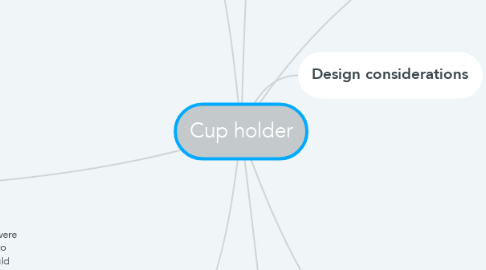
1. Aesthetics
1.1. A consideration that could be worth noting is the potential of having the cup holder as a novelty. By incorporating a novelty such as a kids cartoon then you can extend your market to lower years. Simultaneous to this option you could also do a standard version which would appeal to a more mature age range.
1.2. The overall design and appearance of the product will hopefully appear smooth and slick from the primary users eye. One potential aspect of the aesthetics is to have corners rounded off and a good finish which will look aesthetically pleasing in the light.
1.3. The material used will also play a role in the colour it could be manufactured in. Take for example the use of acrylic will allow for a wider variety of colours in comparison to oak, a hardwood, where colour would be limited to either varnishing or painting the surface.
2. Primary user needs
2.1. The need for the primary user is to have a holder for their cups or drinks on a daily basis which is convent and not too much hassle to use therefore making "life easier".
3. Other stakeholders
3.1. Manufacturers of materials such as the plastics to the woods.
3.2. The focus group when carrying out testings of the product
3.3. Retail experts in shops and businesses
3.4. Transporation companies
4. Manufacture
4.1. Considering both types of potential materials of woods and plastics then if were to scale up the production and turn it into factory made system both materials would have their drawbacks. Both materials are finite resources and so scale of production would be effected as the time taken for finite resources to grow is over millions of years.
4.2. By scaling up production, you allow for the opportunity of bulk buys/sales allowing a bigger gross profit; however, then there is the absence of a personal element and that certain tough to a bespoke product.
5. Target Market
5.1. If, as mentioned before, the product was to become a novelty concept then this would more than likely appeal to a more younger age range such as ages 7-14.
5.2. On the other hand, if the product was to be more of a neutral colour and theme then this would suit a mature age range such as ages 12-16 or even older.
6. Potential materials
6.1. Thermoplastics
6.1.1. Polypropylene - Otherwise known as PP and is used for items such as kitchenware and carpets. The material has properties of been light, hard, impact resistant and chemical resistant.
6.1.2. High density polythene - (HDPE) is chemical resistant, impact resistant and flexible in comparison to other plastics. Is widely used in water tanks, buckets and bowls.
6.2. Thermoset plastics
6.2.1. Urea formaldehyde - A strong, hard but brittle and heat resistant plastic that is used in electrical fittings and domestic appliances.
6.3. Hardwoods
6.3.1. Oak - A very durable wood that is one of the most widely used woods so would be readily available in demand. Mainly used inside of home for furniture. E.g dining tables
6.3.2. Redwood - A lumber that is well known for its durability and weather resistance with a popular rustic look. Most commonly used for fencing for its protection against discolouring from UV light.

